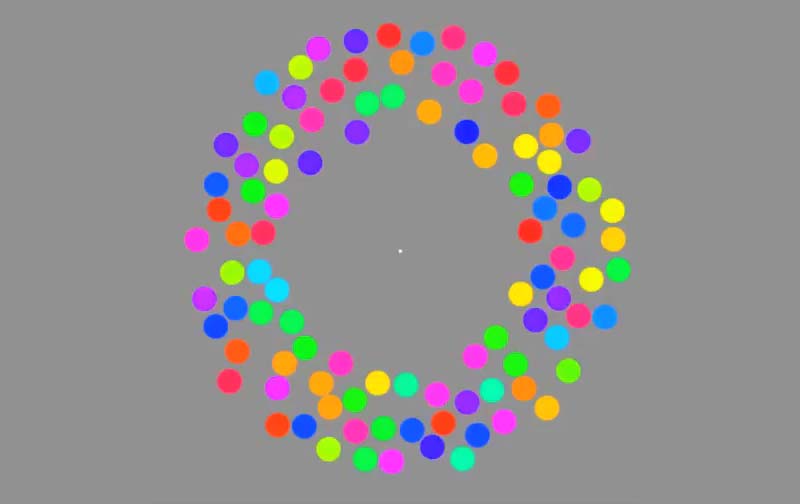Best Illusion of 2011 Reveals Visual Quirk

A mysterious illusion that illustrates how motion can render color changes invisible won the "Best Illusion of the Year" for 2011, and it also taught researchers something they didn't know.
"It is a really beautiful effect, revealing something about how our visual system works that we didn't know before," said Daniel Simons, a professor at the University of Illinois, Champaign-Urbana. Simons studies visual cognition, and did not work on this illusion. Before its creation, scientists didn't know that motion had this effect on perception, Simons said. [Eye Tricks: Gallery of Visual Illusions]
A viewer stares at a speck at the center of a ring of colored dots, which continuously change color. When the ring begins to rotate around the speck, the color changes appear to stop. But this is an illusion. For some reason, the motion causes our visual system to ignore the color changes. (You can, however, see the color changes if you follow the rotating circles with your eyes.) [See Video of Illusion Winner]
This illusion is the work of Jordan Suchow, a graduate student in cognitive science at Harvard University, and his adviser George Alvarez. Their illusion took first place at the conclusion of the seventh annual Best Illusion of the Year Contest in Florida. Suchow discovered it when his laptop, which was displaying a similar set of color-changing circles, slipped and the dots appeared to stop changing.
Perception versus reality
Visual illusions reveal discrepancies between perceptions generated by our brain and physical reality. As a result, they create a window into the basic mechanisms that allow us to experience the world around us, according to the nonprofit Neural Correlate Society, which organizes the contest.
The variations on the winning illusion show that this effect also holds for changes in size, shape, brightness and for background versus foreground motion. And the effect is not absolute; its strength depends on the speed of the motion.
Sign up for the Live Science daily newsletter now
Get the world’s most fascinating discoveries delivered straight to your inbox.
"I have never found any cutoff; any amount of motion seems to do it. What is important is the faster the object moves, the less noticeable the change," Suchow said.
This illusion represents a form of change blindness, which is the failure to notice significant changes from one moment to the next particularly because of a disruption or distraction, according to Simons, the co-author of the book "The Invisible Gorilla: How Our Intuitions Deceive Us" (Broadway, 2011).
Change blindness can involve unexpected changes — such as someone failing to notice they are talking with a different, but similar stranger after a conversation was interrupted, as one experiment has demonstrated. The circle illusion is unique in an important way, Simons said. "In this case you know exactly what is changing and how it is changing, and it is a big, easy-to-see change as long as it is not moving," he said. Even so, once the motion begins, the change disappears.
What's going on?
"So, if I had a complete answer I would be out of a job," Suchow said.
He speculates that the changes fade or disappear because our visual systems might be making the assumption that the circles themselves aren't actually changing even though they appear to be.
Out in the world, things rarely change rapidly in color and brightness and so on on their own. Usually these changes can be attributed to lighting or motion. So our visual system could be making the assumption that the changes are actually just evidence of motion and ignoring them, Suchow said.
There is another way the motion could be changing how our brains perceive the circles, according to Mark Changizi, the director of human cognition at 2AI labs and author of the book "The Vision Revolution: How the Latest Research Overturns Everything We Thought We Knew About Human Vision" (BenBella Books, 2010).
The shimmering of the stationary circles as they change color suggests many different objects moving toward or away from the viewer, independent of each other. However, once the ring containing the circles begins to rotate as a whole, without the complex rotation properties expected for separate objects, the visual system may begin perceiving the ring as a single object and disregard the individual changes, according to Changizi.
Changizi points out that it is possible to at least partially resolve the illusion by shifting your attention to one of the circles as it rotates while keeping your eyes fixated on the center speck. The circle's color changes then become more visible.
"It is more of a tracking problem," he said.
Other winners can be viewed here.
You can follow LiveScience writer Wynne Parry on Twitter @Wynne_Parry. Follow LiveScience for the latest in science news and discoveries on Twitter @livescience and on Facebook.











